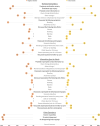Quality of care offered by health care retail markets for medication abortion self-management: Findings from states in Nigeria and India
- PMID: 39761244
- PMCID: PMC11703032
- DOI: 10.1371/journal.pgph.0003971
Quality of care offered by health care retail markets for medication abortion self-management: Findings from states in Nigeria and India
Abstract
Dispensing of misoprostol and mifepristone by pharmacies and chemist shops for self-management of medication abortion (MA) fills a crucial gap in settings where abortion care by trained health professionals is not readily available. This promising service delivery pathway, endorsed by the World Health Organization (WHO), is hindered by concerns of poor-quality care. Simulated clients collected data on MA pill dispensing practices from 92 pharmacies and chemist shops in three Nigerian states and 127 pharmacies in an Indian state that we have anonymized. Guided by the WHO's abortion guideline, we measured process-related quality indicators such as medication use instructions, warning signs, and respectful treatment among other aspects. We aggregated indicators under three domains: technical competence, information given to clients, and client experience. Overall, 51% of facilities in the Nigerian states and 32% in the Indian state offered MA pills. Most dispensing facilities offered the misoprostol-only regimen in Nigeria (68%) and the combination regimen in the Indian state (83%). Among facilities offering MA pills, 26% in Nigeria and 78% in the Indian state provided correct instructions on route of pill administration. Accurate information on the appropriate interval between pill type in the combination regimen was low in Nigeria (27%) and the Indian state (14%). Excessive bleeding as a warning sign was discussed more frequently in the Indian (56%) versus Nigerian states (32%); other abnormal bleeding patterns were rarely mentioned. Aggregate technical competency scores were low at 18% in Nigeria and 34% in the Indian state, with highest scores for client experience at 90% and 91% respectively. Findings suggest that people using MA pills purchased from the retail market are not given accurate and adequate information for most effective self-use. If MA self-management remains outside regulatory boundaries, technical quality will remain sub-standard, imposing unnecessary costs to people, their health, and health systems.
Copyright: © 2025 Shankar et al. This is an open access article distributed under the terms of the Creative Commons Attribution License, which permits unrestricted use, distribution, and reproduction in any medium, provided the original author and source are credited.
Conflict of interest statement
The authors have declared that no competing interests exist.
Figures


Similar articles
-
Exploring the availability and accessibility of medication abortion pills in Delhi, India: A mystery client study in community pharmacies.Contraception. 2025 Mar;143:110745. doi: 10.1016/j.contraception.2024.110745. Epub 2024 Nov 8. Contraception. 2025. PMID: 39522632
-
Quality of information offered to women by drug sellers providing medical abortion in Nigeria: Evidence from providers and their clients.Front Glob Womens Health. 2022 Aug 17;3:899662. doi: 10.3389/fgwh.2022.899662. eCollection 2022. Front Glob Womens Health. 2022. PMID: 36060610 Free PMC article.
-
Pathways to seeking medication abortion care: A qualitative research in Uttar Pradesh, India.PLoS One. 2019 May 13;14(5):e0216738. doi: 10.1371/journal.pone.0216738. eCollection 2019. PLoS One. 2019. PMID: 31083665 Free PMC article.
-
Reconceptualizing safe abortion and abortion services in the age of abortion pills: A discussion paper.Best Pract Res Clin Obstet Gynaecol. 2020 Feb;63:45-55. doi: 10.1016/j.bpobgyn.2019.07.012. Epub 2019 Aug 6. Best Pract Res Clin Obstet Gynaecol. 2020. PMID: 31494046 Review.
-
Medical abortion offered in pharmacy versus clinic-based settings.Cochrane Database Syst Rev. 2021 Jun 11;6(6):CD013566. doi: 10.1002/14651858.CD013566.pub2. Cochrane Database Syst Rev. 2021. PMID: 34114643 Free PMC article.
Cited by
-
Quality of Information on Medication Abortion in Private Pharmacies: Results from a Mystery Client Study in Kinshasa, Democratic Republic of Congo.Healthcare (Basel). 2025 Feb 24;13(5):491. doi: 10.3390/healthcare13050491. Healthcare (Basel). 2025. PMID: 40077053 Free PMC article.
References
-
- Bearak J, Popinchalk A, Ganatra B, Moller AB, Tunçalp Ö, Beavin C, et al.. Unintended pregnancy and abortion by income, region, and the legal status of abortion: estimates from a comprehensive model for 1990–2019. Lancet Glob Health. 2020;8(9):e1152–e61. doi: 10.1016/S2214-109X(20)30315-6 - DOI - PubMed
-
- Grimes DA, Benson J, Singh S, Romero M, Ganatra B, Okonofua FE, et al.. Sexual and reproductive health 4—Unsafe abortion: the preventable pandemic. Lancet. 2006;368(9550):1908–19. - PubMed
-
- World Health Organization. WHO Model List of Essential Medicines (March 2005). Geneva, Switzerland: World Health Organization; 2005.
-
- World Health Organization. Abortion care guideline. Geneva, Switzerland: World Health Organization; 2022.
LinkOut - more resources
Full Text Sources
Miscellaneous
